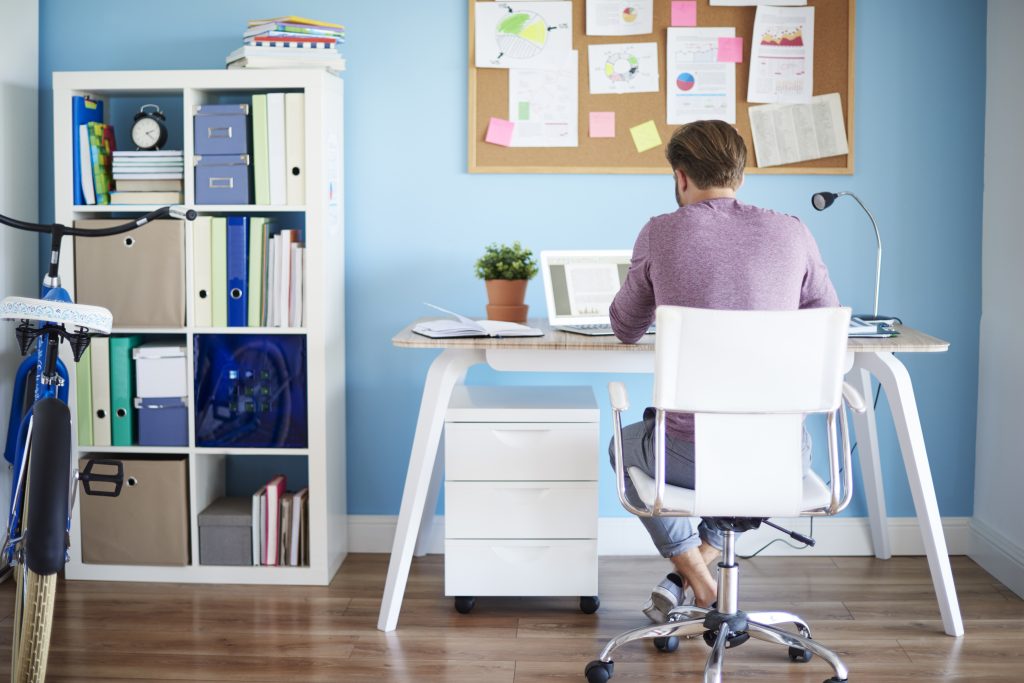Creating an efficient home office isn’t just about having a desk and chair—it’s about building a workspace that maximizes productivity, comfort, and focus. With remote work becoming a permanent fixture for many professionals, strategic layouts, ergonomic furniture, and productivity-focused technology have become essential. In 2025, with the rise of AI-powered work tools, smart wellness devices, and hybrid work culture, designing your space has never been more important.

Why Home Office Design Matters in 2025
Remote work is no longer a temporary trend—it’s a global shift. According to a 2024 Gallup report, 72% of U.S. employees now work from home at least part-time, making home offices a critical productivity factor (Gallup, 2024). Poorly designed setups can cause distractions, physical discomfort, and lower efficiency. A thoughtfully planned space, on the other hand, can boost focus, prevent health problems, and help you maintain a healthy work-life balance.
Benefits of a well-designed home office include:
- Faster task completion and fewer errors
- Better posture and reduced back, neck, and wrist strain
- Improved focus and less burnout
- Clear separation between work and personal life
Step 1: Choose the Right Location
The location of your home office plays a big role in productivity. A 2023 Harvard Business Review article highlights that separating your workspace from living areas can help signal your brain that it’s “work time”, improving focus (HBR, 2023).
Tips for choosing the best spot:
- Use a room with a door to reduce noise and interruptions.
- Position your desk near a window for natural light, which boosts mood and energy.
- Avoid working in bedrooms—blending rest and work areas can sleep quality.
- For small apartments, consider creative solutions like transforming a closet into a “cloffice” or using a fold-out desk.
Step 2: Invest in Ergonomic Furniture
Ergonomics is essential for both comfort and long-term health. The American Chiropractic Association reports that ergonomic chairs can reduce back pain by up to 54% for remote workers (ACA, 2024).
Must-have ergonomic upgrades:
- Adjustable Chair: Supports the natural curve of your spine and allows feet to rest flat.
- Proper Desk Height: Keeps elbows at a 90° angle and wrists neutral.
- Monitor Placement: The top of your screen should be at or slightly below eye level.
- Sit-Stand Desk: Alternating between sitting and standing improves circulation and reduces fatigue.
- Anti-Fatigue Mat: For standing desk users, reduces strain on feet and legs.
Step 3: Optimize Lighting for Productivity
Lighting impacts mood, focus, and eye health. Poor lighting can cause headaches and drowsiness.
Lighting tips:
- Combine natural light with high-quality task lighting.
- Use daylight-simulating LED bulbs for consistent brightness.
- Position your desk to avoid direct glare on your monitor.
- For video calls, consider a ring light or LED panel to ensure a professional appearance.
Step 4: Harness Technology to Your Advantage
The right tech setup can streamline work and reduce stress.
Tech essentials for 2025:
- Dual Monitors: Improve multitasking and reduce time switching between windows.
- Noise-Canceling Headphones: Block out background sounds during calls or deep work.
- Cable Management Systems: Keep cords tidy and your desk clear.
- AI Productivity Tools: Apps like Notion AI, ClickUp AI, or Microsoft Copilot automate tasks, draft and summarize meeting notes.
- Smart Assistants: Use Alexa or Google Nest for reminders, calendar updates, and even controlling lights or music.
- Webcam Upgrades: High-quality cameras help you appear sharp and professional in meetings.
Step 5: Incorporate Smart Storage Solutions
A cluttered desk can lead to mental clutter, reducing efficiency.
Storage options:
- Floating shelves to maximize wall space
- Filing cabinets or mobile pedestals
- Drawer organizers for stationery and tech accessories
- Labeled bins for easy supply access
- Rolling carts for flexible storage that can move with you
Step 6: Personalize Your Workspace (Without Overdoing It)
A workspace should inspire creativity and motivation but remain free of distractions.
Ideas for personal touches:
- Add plants—research from the University of Exeter shows greenery can boost productivity by up to 15% (University of Exeter, 2014).
- Choose a neutral base color palette with a few bold accent items.
- Limit personal photos to one or two frames to maintain focus.
- Use a vision board or motivational quotes to keep goals visible.
Step 7: Manage Noise and Distractions
Noise can destroy focus, especially in busy households or city environments.
Noise management strategies:
- Install soundproofing panels or use thick rugs and curtains to absorb sound.
- Play white noise or focus-enhancing background music.
- Set clear “do not disturb” rules with family or roommates during work hours.
- Use a visual signal like a desk light to indicate when you’re in a meeting.
Step 8: Implement Zoning for Different Tasks
If you have the space, create multiple zones to match your work needs:
- Primary Desk Area: For focused computer-based work.
- Standing Desk or Counter Space: For calls, brainstorming, and shorter tasks.
- Reading Corner: A comfortable chair for reviewing or creative thinking.
Step 9: Add Wellness-Focused Features
A 2025 design trend is integrating wellness into the workspace to reduce stress and improve health.
Wellness additions to consider:
- Desk treadmills or under-desk bikes for light movement during work.
- Lighting systems that adjust brightness and color temperature throughout the day to support natural circadian rhythms.
- Essential oil diffusers for a calming environment.
- Ergonomic keyboards and mice to prevent repetitive strain injuries.
- Mini stretching zones or yoga mats nearby for quick breaks.
Step 10: Maintain and Evolve Your Setup
A functional office requires ongoing maintenance. Schedule weekly cleaning sessions to keep your workspace fresh and clutter-free. Every few months, reassess your setup—are your needs changing? Is your tech outdated? Small adjustments can keep your space optimized for performance.
The Future of Home Offices
Looking ahead, the next wave of home office design will focus on AI integration, health monitoring, and sustainability. Expect more desks with built-in posture sensors, controlled chairs, and solar-powered lighting. The key is flexibility—your office should adapt as your work and lifestyle evolve.
Final Thoughts
Your home office is more than a desk—it’s your productivity hub. The right design can improve focus, comfort, and efficiency, while the wrong one can cause burnout and frustration. By combining ergonomic furniture, thoughtful layouts, smart lighting, and personal touches, you can create a workspace that supports maximum productivity every day. In 2025 and beyond, the best home office is one that grows with you.
Reference
- Remote Work Productivity Study: https://www.greatplacetowork.com
- Plants In The Office Make You 15% More Productive, https://www.planteriagroup.com
- 8 Design Tips for a More Functional Office, According to Designers, https://www.thespruce.com









